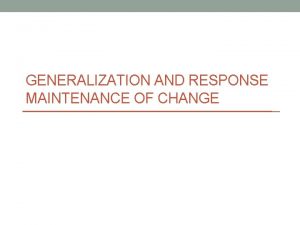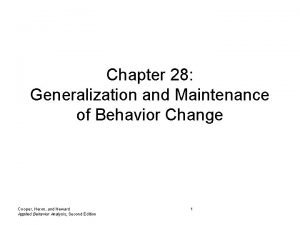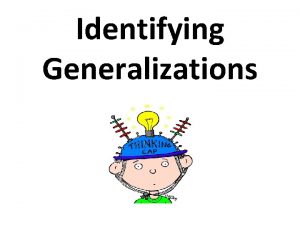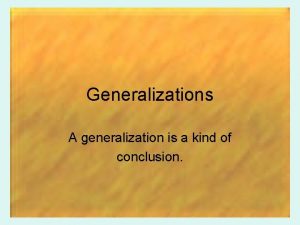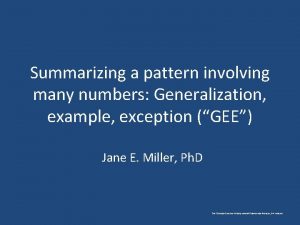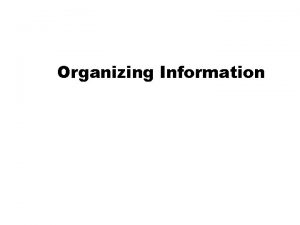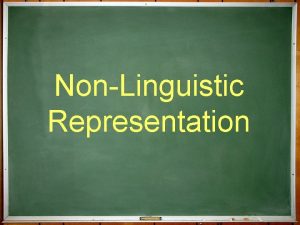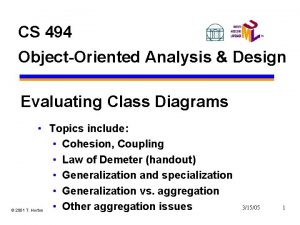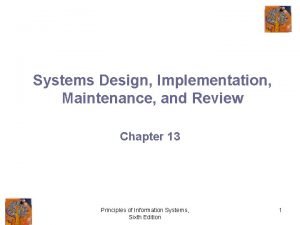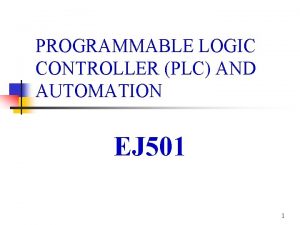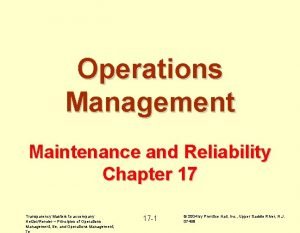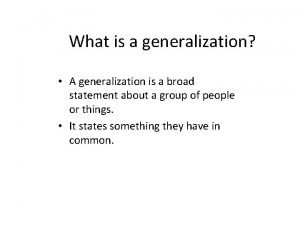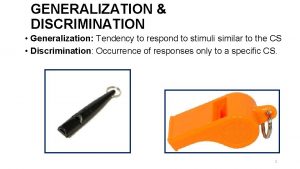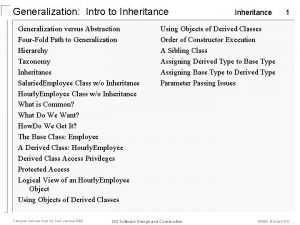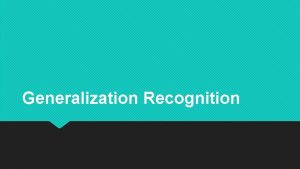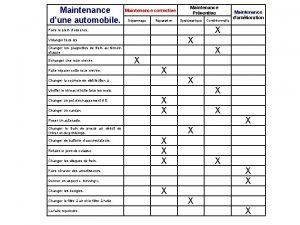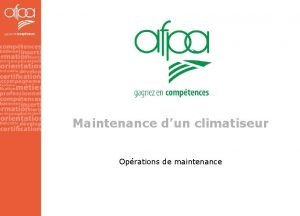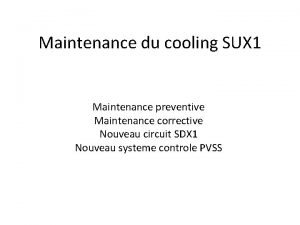GENERALIZATION AND RESPONSE MAINTENANCE OF CHANGE Generalization Is











































- Slides: 43

GENERALIZATION AND RESPONSE MAINTENANCE OF CHANGE

Generalization • Is one of the seven defining characteristics of ABA • Is defined and stressed within important facets • Time • Settings • Behaviors • Etc.

Response Maintenance • Extent to which a learner continues to perform the target behavior after the intervention has been terminated • Both concepts are important

Setting / Situation Generalization • Extent to which a learner emits the target behavior in a setting that is different from the instructional setting • Generalization Setting • Any place or stimulus that differs in some meaningful way from the instructional setting • Instructional Setting • Environment where instruction occurs • Includes all aspects of the environment • Can be planned or unplanned

Response Generalization • Extent to which a learner emits untrained responses that are functionally equivalent to the trained target behavior • Is what we strive for

Generalized Behavior • Exists on a continuum • Some interventions produce a great deal of generalized behavior change • Some interventions produce a small amount of generalized behavior change • Change can occur: • Isolation of one another • In combination with each other

Overgeneralization • Learner emits the target behavior in the presence of stimuli that, although similar in some way to the instructional examples or situation, are inappropriate occasions for the behavior • Behavior comes under the control of a stimulus class that is too broad

Faulty Stimulus Control • Target behavior comes under the restricted control of an irrelevant antecedent stimulus

Other Types of Generalized Outcomes • Stimulus equivalence • Responding to untrained and nonreinforced stimulus-stimulus relations following the reinforcement of responses to some stimulus -stimulus relations • Contingency adduction • Behavior that was initially selected and shaped under one set of conditions is recruited by a different set of contingencies and takes on a new function in a person’s repertoire

Generalization Across Subjects • Changes in the behavior of people that occur when contingencies are applied to other people • Also called vicarious reinforcement, ripple effect, & spillover effect

Generalized Outcomes • Requires Planning • Selecting target behaviors that will meet natural contingencies of reinforcement • Specifying desired variations of the target behavior • Specify situations where target behavior should (and should not) occur after instruction has ended

Target Behaviors • Should be selected carefully • Need to be age appropriate • Must have a degree of skill which represents normalization • Choose only those behaviors that will produce reinforcers in the post-intervention environment • Don’t make behavior changes that will not meet natural communities of reinforcement

Most Important Criterion • A behavior is only functional to the extent that it produces reinforcement for the learner • Behaviors that are not followed by reinforcers (on at least some occasions) will not be maintained

Naturally Existing Contingency • Any contingency of reinforcement (or punishment) that operates independent of the behavior analyst’s efforts • Includes • Contingencies that operate without social mediation • Socially mediated contingencies contrived and implemented by other people

Contrived Contingency • Any contingency of reinforcement (or punishment) designed and implemented to achieve acquisition, maintenance, and/or generalization of a targeted behavior change

Planning for Generalized Behavior Change • List all the behaviors that need to be changed • List all the settings & situations in which the target behavior should (or should not) occur

Pre-intervention Planning • Teach the full range of relevant stimulus conditions & response requirements • Make the instructional setting similar to the generalization setting • Maximize the target behavior’s contact with reinforcement in the generalization setting • Mediate generalization • Train to generalize

Teach Relevant Stimulus Conditions and Response Requirements • Teach sufficient stimulus examples • Teach sufficient response examples • General case analysis • Negative teaching examples

Teach Sufficient Stimulus Examples • Teach every desired form of a target behavior in every setting/situation in which it may be needed • Eliminates need to program for response generalization & setting/situation generalization • Problem: Seldom possible & never practical

Alternative • Teach the learner to respond to a subset of all of the possible stimulus & response examples • Then assess the learner’s performance on untrained examples (referred to as a generalization probe)

General Rule • More examples used during instruction, more likely the learner will respond correctly to untrained examples or situation • Number of examples needed varies due to • Complexity of the target behavior • Teaching procedures employed • Learner’s opportunities to emit the target behavior under various conditions • Naturally existing contingencies of reinforcement • Learner’s history of reinforcement for generalized responding

Teach Sufficient Response Examples • Practice with a variety of response categories. • Helps to ensure that acquisition of desired response forms • Promotes response generalization • Multiple exemplar training • Usually incorporates both stimulus & response variations

General Case Analysis • Method for selecting teaching examples that represent the full range of stimulus variations & response requirements in the generalization setting • Also referred to as general case strategy

Negative Teaching Examples • Explicit teaching of where and when not to use the target behavior may also be necessary • Don’t do the behavior under the following circumstances • Provides practice for discriminating stimulus situations in which the target behavior should not be emitted • Sharpens stimulus control

Have Instructional Setting Similar to the Generalization Setting • Include typical features of the generalization setting in the instructional setting • Vary noncritical aspects of the instructional setting within and across the teaching session

Benefits of Programming Common Stimuli • Conducting instruction in natural settings is not always possible • Community-based training may not expose learners to the full range of examples they are likely to encounter later in the same setting • Instruction in natural settings may be less effective & efficient than classroom instruction because the trainer cannot halt natural flow of events to contrive variety of training trials • Instruction in simulated settings can be safer

Two step process • Identify salient stimuli that characterize the generalization setting(s) • Incorporate those stimuli into the instructional setting

Benefits of Teaching Loosely • Reduces the likelihood that a single or small group of noncritical stimuli will acquire exclusive control over the target behavior • Including noncritical stimuli during instruction increases the probability that the generalization setting will include at least some of the stimuli that were present during instruction

Teaching Loosely Suggestions (Baer, 1999) • Use two or more teachers • Teach in two or more places • Teach from a variety of positions • Vary your tone of voice and choice of words • Show stimuli from a variety of angles • Vary the reinforcers • Teach in varying lighting, temperature and noise level conditions • Vary decorations, furniture, & their locations • Vary times of day for training sessions • Vary the of the training settings • Vary the smells in the training settings • Vary the content of what’s being taught (within limits possible)

Maximize Contact with Reinforcement • Teach behavior to levels required by natural contingencies • Program indiscriminable contingencies • Intermittent schedules of reinforcement • Delayed rewards • Set behavior traps • Ask people in the generalization setting to reinforce the behavior • Teach the learner to recruit reinforcement

Maximize Contact with Reinforcement • Indiscriminable contingency • A contingency in which the learner cannot discriminate whether the next response will produce reinforcement • Reinforcement is contingent on some, but not all, occurrences of the target behavior in the generalization setting • The learner is unable to predict which responses will produce reinforcement

Intermittent Schedules of Reinforcement • Behaviors that have a history of intermittent schedules of reinforcement continue to be emitted for longer periods of time after reinforcement is not available

Success of Delayed Rewards Depends on • The indiscriminability of the contingency • The learner understanding the relation between emitting the target behavior at an earlier time and receiving a reward later

Some Guidelines for Programming Indiscriminable Contingencies • Use CRF during initial acquisition or when strengthening little-used behaviors • Systematically thin the schedule of reinforcement • Gradually increase the response-to-reinforcement delay when using delayed rewards • Explain what the reward is for when using delayed rewards

Behavior Traps • Interrelated contingencies of reinforcement can be powerful, producing substantial and longlasting behavior changes • Relatively simple responses are necessary to enter the trap, yet once entered, the trap cannot be resisted in creating general behavior change

Behavior Traps Share Four Features • Are “Baited” with irresistible reinforcers that “lure” the learner to the trap • Only a low effort response already in the learner’s repertoire is necessary to enter the trap • Once inside the trap, interrelated contingencies of reinforcement motivate the learner to acquire, extend, & maintain targeted academic and/or social skills • Remains effective for a long time because learners show few, if any, satiation effects

Mediate Generalization • Arranging for some object or person to act as a medium that ensures the transfer of the target behavior from instructional setting to the generalization setting • Contrive a mediating stimulus • Teach self-management skills

Mediating Stimuli • Must be made functional for the target behavior during instruction • Functional if it reliably prompts the learner in performing the target behavior • Must be transported easily to the generalization setting • Transportable if it easily goes with the learner to all important generalization settings

Mediate Generalization • Teach self-management skills • The learner is one element that is always present in every instructional and generalization setting • If the learner is taught a behavior that serves to prompt or reinforce the target behavior in all relevant settings, appropriate times, and relevant forms, then the generalization of the target behavior is ensured

Train to Generalize • Reinforce response variability • Emitting a variety of responses; valued behavior, viewed as novel or creative • Lag reinforcement schedule: reinforcement contingent on a response different in some defined way from the previous response • Instruct the learner to generalize • Tell the learner about the possibility of generalization • Ask the learner to perform the behavior

Modifying and Terminating Interventions • Withdrawal of a successful intervention should be carried out in a systematic & careful fashion • When deciding how soon or how swiftly to withdraw intervention components consider: • Complexity of the intervention • Ease or speed with which the behavior changed • Availability of naturally existing contingencies of reinforcement for the new behavior

To Accomplish • Modifying one or more parts of the three-term contingency • Antecedents, prompts, or cue-related stimuli • Task requirements and criteria • Consequences or reinforcement variables

Conclusion • Is an important part of the training process • Is important for real life situations • Want natural occurring stimuli to reinforce the participant.
 Contrived mediating stimulus
Contrived mediating stimulus Contrived mediating stimulus
Contrived mediating stimulus Acquisition fluency maintenance generalization
Acquisition fluency maintenance generalization Natural and forced response
Natural and forced response Natural and forced response
Natural and forced response Primary immune response and secondary immune response
Primary immune response and secondary immune response Example of chemical changes
Example of chemical changes Absolute change and relative change formula
Absolute change and relative change formula Difference in physical and chemical changes
Difference in physical and chemical changes Supply and demand curve shifts
Supply and demand curve shifts What is an example of chemical and physical change
What is an example of chemical and physical change Rocks change due to temperature and pressure change
Rocks change due to temperature and pressure change Whats chemical change
Whats chemical change First and second order change
First and second order change Painting a wall physical or chemical change
Painting a wall physical or chemical change Integers definition
Integers definition Input and output markets
Input and output markets Change your water change your life
Change your water change your life Proactive and reactive change
Proactive and reactive change Spare change physical versus chemical change
Spare change physical versus chemical change Physical change
Physical change Chemical change in baking
Chemical change in baking Chopping wood is a physical or chemical change
Chopping wood is a physical or chemical change Climate change 2014 mitigation of climate change
Climate change 2014 mitigation of climate change Maintenance of patient records and reports
Maintenance of patient records and reports Marzano graphic organizers
Marzano graphic organizers Generalization clue words
Generalization clue words Conclusion or generalization
Conclusion or generalization Generalization and example pattern
Generalization and example pattern Signal words of classification
Signal words of classification Generalization and example pattern organizer example
Generalization and example pattern organizer example Generalization and example pattern organizer example
Generalization and example pattern organizer example Generalization and specialization in java
Generalization and specialization in java Preventive and predictive maintenance of hydro power plant
Preventive and predictive maintenance of hydro power plant System maintenance and review
System maintenance and review Aircraft maintenance planning
Aircraft maintenance planning Plc
Plc Operation and maintenance dairy plant
Operation and maintenance dairy plant Maintenance function
Maintenance function Maintenance and reliability in operations management
Maintenance and reliability in operations management Mao consolidation and maintenance of power
Mao consolidation and maintenance of power 5988-e no faults
5988-e no faults Premier asset management llc
Premier asset management llc Ideal hospital framework
Ideal hospital framework
